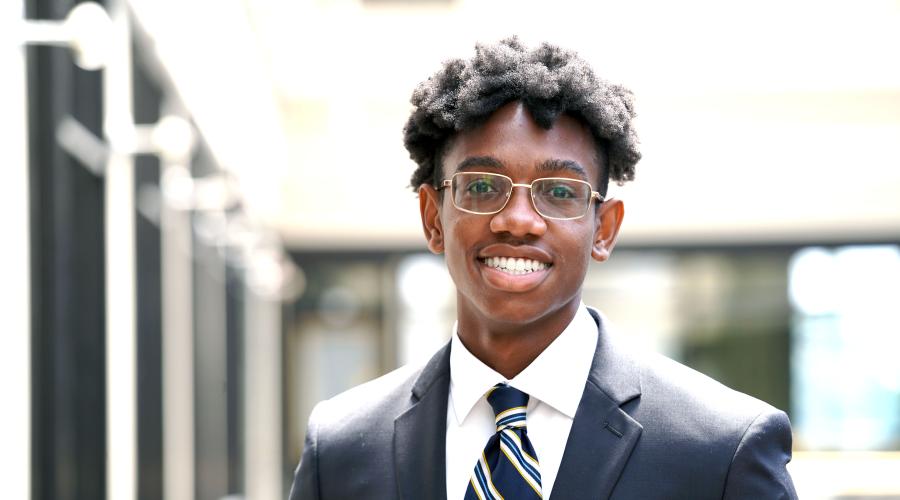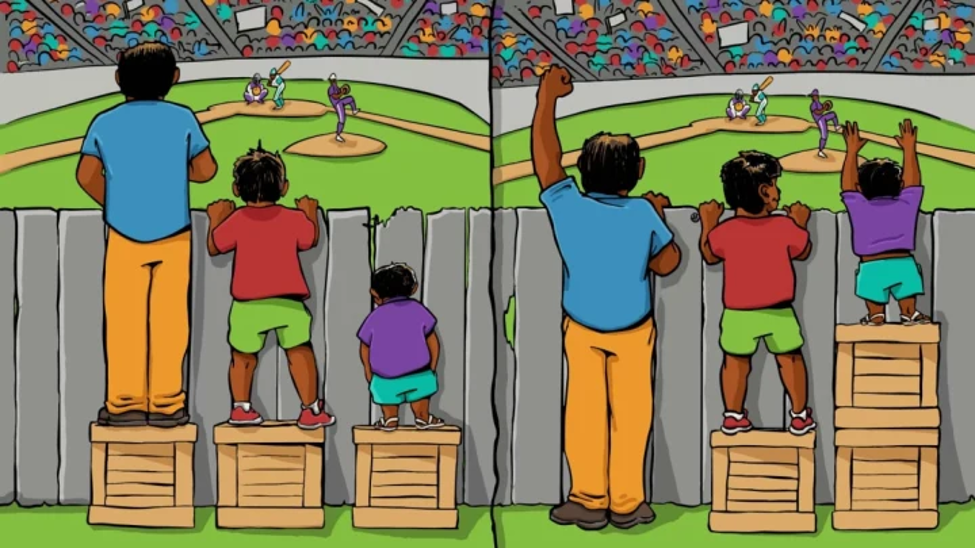
Equity in Action
By Sakiel Ruff
Whenever I hear the word equity, I think about 2020 when I first learned about the difference between equity and equality. Equality is when everyone gets the same resources, but equity is where resources are distributed in a way that allows for equal outcomes. Whenever I hear the word equity, I think of visual demonstrations like the one below. People say pictures are worth a thousand words, but this is much more. Not only is this a picture that educates its viewer, but it also prompts the viewer to change their perception of reality. This photo is a visual metaphor of equity that shifts the viewer’s paradigm.

Most of us agree that equity is essential to a just society, but we cannot practice it for some reason. As I said, this word brings me back to 2020, when I first heard of a distinction between equity and equality. This was the same year I learned that COVID-19, a highly contagious virus, disproportionately affects people of color. This was the same year Breonna Taylor, George Floyd, and Rayshard Brooks were murdered. I was reminded for the millionth time that the color of my skin puts a target on my back, especially in the eyes of law enforcement. This was the same year I was applying to university and started to look at demographic statistics for the colleges I was interested in, only to see that black people, specifically black men, are disproportionately underrepresented in higher education. The list goes on. 2020 made it abundantly clear that our society is inequitable. By no means do different demographics receive equitable outcomes. To this day, I see no changes.
As I reflect upon my thoughts going into my senior year of high school in 2020, I remember the powerlessness I felt every time I stepped outside. I still have that feeling as I enter my sophomore year at Cornell. I want to say this feeling remains in its intensity, but it does not. I want to capture the same feeling because I know the sense of safety I feel now is a false cognition. I only now feel safe because I am often trapped in the bubble of Cornell’s campus that shields me from the real world. When the bubble pops, I am constantly reminded of how it is in “the real world,” which sends me into spiraling thoughts. I should feel safer because living is safer, but it is not. With the murder of Jayland Walker, I am reminded yet again that I am not safe. I see no changes.

Equity has become a large-scale private sector focus in recent years. Since 2020, a large portion of the American populace has fallen into performative hyper-liberalism. Too many people focus on symbolic forms of reparations and tokenism to solve institutional problems. I greatly appreciate that there is a lot of talk about creating an equitable society. However, equity is not thoroughly practiced. This concept can be seen in professional environments through “Diversity, Equity & Inclusion” initiatives headed by white women that do more harm than good to the people they are trying to protect from harassment. I have witnessed this many times and heard many stories about the counterintuitive nature of these programs. Diversity programs can easily make people uncomfortable or even create a more hostile environment. I have yet to experience a diversity program that I feel served its true purpose. Although they help inform the ignorant on the basics of diversity, the execution of these initiatives need to be more individualized and specific to exact lasting change. Everyone in those spaces has implicit biases. Everyone’s biases must be evaluated and called out, no matter what. However, that process of self-reflection and collective accountability does not happen. The very person who is heading the initiative may be the same one who clutches her purse as I walk to my next class.
In the context of Buffalo, the idea of equity is quite important to me. My grandparents live on the east side of Buffalo, where 85% of the black population of Buffalo lives. This is my home for the summer. The east side is a neighborhood characterized by some people as a food apartheid and a place of “dissolving infrastructure.” That is what I have heard since I came to Buffalo. Although there is a strong community with a beautiful history, the claims of marginalization are valid. Work needs to be done.
I know millions of dollars have been donated to the east side of Buffalo in light of the Tops massacre on May 14th, but I fear the money will be poorly utilized. This past Sunday, my grandmother called me downstairs to say good morning and asked me how I felt about what was being done with the donated money. The news says that the money is being “distributed through the black community,” but that statement is vague. My grandparents live five blocks away from the supermarket and have not seen any service to ameliorate the harm that the massacre has caused other than food pop-ups. Food pop-ups are essential, but the state of the east side still begs the question, is this money going to create long-term systemic change rather than just short-term emergency assistance? I have heard news about a large portion of the money going to black-owned businesses in the area to reinvest in the community. Black-owned business reinvestment is important, but most people on the east side are not business owners. The business owners are not the people most affected by the absence of the grocery store; it is the loved ones of the victims, the immobile, and the impoverished we need to be investing in. Two months after the shooting, the supermarket opened again. This is a step forward for the community as a local food source is reinstated, but this comes with an abundance of issues. Even with the money donated to reinvest into the east side of Buffalo, I see no changes.
I have a lot on my mind regarding equity and how I perceive it in my everyday life; this is just the tip of the iceberg. I feel that America likes how equity looks on paper but will never properly practice it. The steps needed to elevate marginalized groups are not taken to its fullest extent because true equity makes those in power uncomfortable. Much of this is attributed to collective action issues, reluctance, and plain inaction. I have been in too many spaces where we focus on making the change towards an equitable society, but nothing actually gets done. On occasion, there are small wins that come about, and I am grateful for those. However, the very structure of our inequitable country needs to be shifted to match the idea represented in the first photo of this journal. We have spent centuries trying to alleviate issues regarding inequality and inequity, but still have the same problems. There has been too much talk of an equitable society with too little action. Private and public efforts have been perfunctory when it comes to large-scale solutions. The black community is not alone in being promised equity without realizing tangible solutions; I am sure that most people can agree that more needs to be done. As I close this journal entry, I suggest you listen to “Changes” by Tupac. He echoes the same sentiments I wrote in this journal, rapping the words,“I see no changes.”

